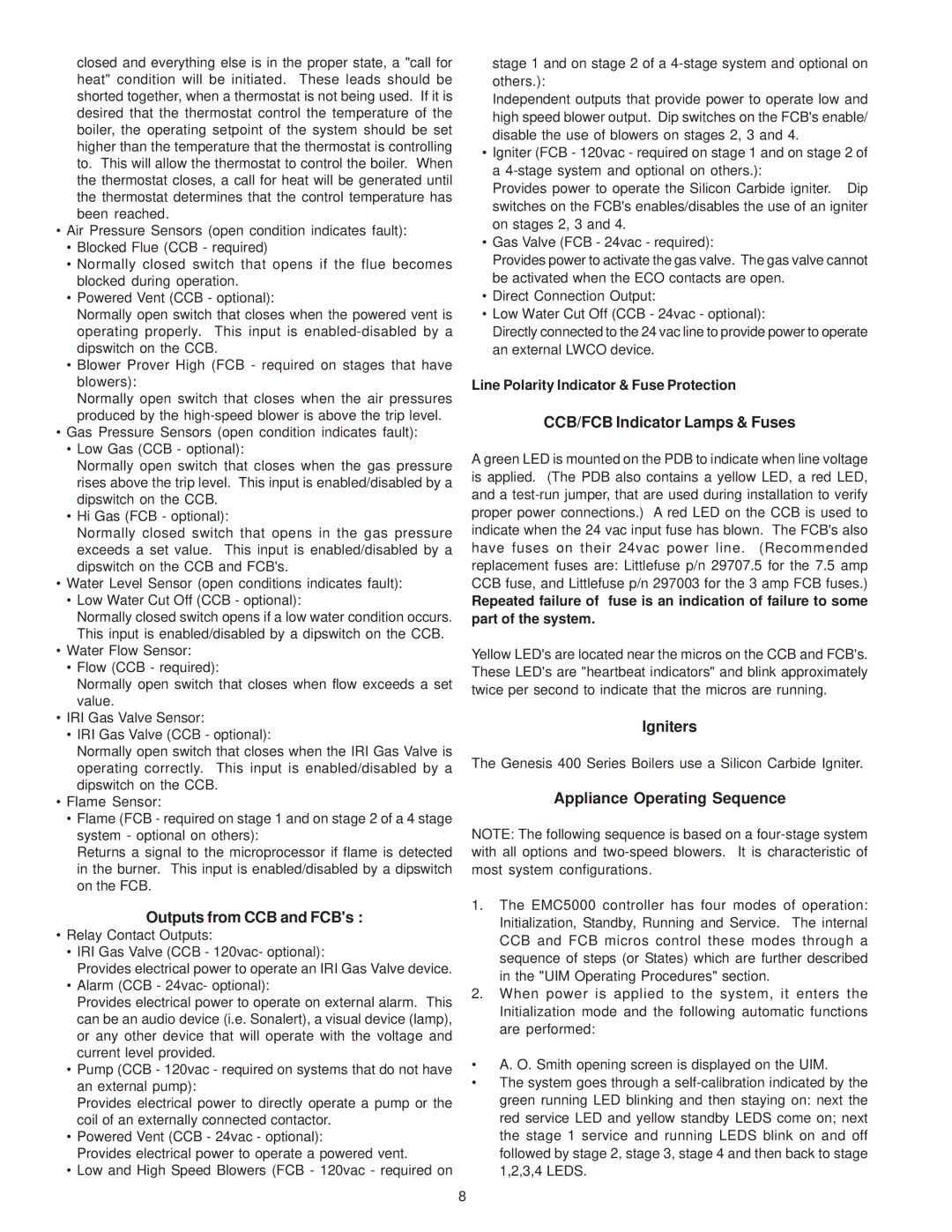closed and everything else is in the proper state, a "call for heat" condition will be initiated. These leads should be shorted together, when a thermostat is not being used. If it is desired that the thermostat control the temperature of the boiler, the operating setpoint of the system should be set higher than the temperature that the thermostat is controlling to. This will allow the thermostat to control the boiler. When the thermostat closes, a call for heat will be generated until the thermostat determines that the control temperature has been reached.
•Air Pressure Sensors (open condition indicates fault):
•Blocked Flue (CCB - required)
•Normally closed switch that opens if the flue becomes blocked during operation.
•Powered Vent (CCB - optional):
Normally open switch that closes when the powered vent is operating properly. This input is enabled-disabled by a dipswitch on the CCB.
•Blower Prover High (FCB - required on stages that have blowers):
Normally open switch that closes when the air pressures produced by the high-speed blower is above the trip level.
•Gas Pressure Sensors (open condition indicates fault):
•Low Gas (CCB - optional):
Normally open switch that closes when the gas pressure rises above the trip level. This input is enabled/disabled by a dipswitch on the CCB.
•Hi Gas (FCB - optional):
Normally closed switch that opens in the gas pressure exceeds a set value. This input is enabled/disabled by a dipswitch on the CCB and FCB's.
•Water Level Sensor (open conditions indicates fault):
•Low Water Cut Off (CCB - optional):
Normally closed switch opens if a low water condition occurs. This input is enabled/disabled by a dipswitch on the CCB.
•Water Flow Sensor:
•Flow (CCB - required):
Normally open switch that closes when flow exceeds a set value.
•IRI Gas Valve Sensor:
•IRI Gas Valve (CCB - optional):
Normally open switch that closes when the IRI Gas Valve is operating correctly. This input is enabled/disabled by a dipswitch on the CCB.
•Flame Sensor:
•Flame (FCB - required on stage 1 and on stage 2 of a 4 stage system - optional on others):
Returns a signal to the microprocessor if flame is detected in the burner. This input is enabled/disabled by a dipswitch on the FCB.
Outputs from CCB and FCB's :
•Relay Contact Outputs:
•IRI Gas Valve (CCB - 120vac- optional):
Provides electrical power to operate an IRI Gas Valve device.
•Alarm (CCB - 24vac- optional):
Provides electrical power to operate on external alarm. This can be an audio device (i.e. Sonalert), a visual device (lamp), or any other device that will operate with the voltage and current level provided.
•Pump (CCB - 120vac - required on systems that do not have an external pump):
Provides electrical power to directly operate a pump or the coil of an externally connected contactor.
•Powered Vent (CCB - 24vac - optional):
Provides electrical power to operate a powered vent.
•Low and High Speed Blowers (FCB - 120vac - required on
stage 1 and on stage 2 of a 4-stage system and optional on others.):
Independent outputs that provide power to operate low and high speed blower output. Dip switches on the FCB's enable/ disable the use of blowers on stages 2, 3 and 4.
•Igniter (FCB - 120vac - required on stage 1 and on stage 2 of a 4-stage system and optional on others.):
Provides power to operate the Silicon Carbide igniter. Dip switches on the FCB's enables/disables the use of an igniter on stages 2, 3 and 4.
•Gas Valve (FCB - 24vac - required):
Provides power to activate the gas valve. The gas valve cannot be activated when the ECO contacts are open.
•Direct Connection Output:
•Low Water Cut Off (CCB - 24vac - optional):
Directly connected to the 24 vac line to provide power to operate an external LWCO device.
Line Polarity Indicator & Fuse Protection
CCB/FCB Indicator Lamps & Fuses
A green LED is mounted on the PDB to indicate when line voltage is applied. (The PDB also contains a yellow LED, a red LED, and a test-run jumper, that are used during installation to verify proper power connections.) A red LED on the CCB is used to indicate when the 24 vac input fuse has blown. The FCB's also have fuses on their 24vac power line. (Recommended replacement fuses are: Littlefuse p/n 29707.5 for the 7.5 amp CCB fuse, and Littlefuse p/n 297003 for the 3 amp FCB fuses.)
Repeated failure of fuse is an indication of failure to some part of the system.
Yellow LED's are located near the micros on the CCB and FCB's. These LED's are "heartbeat indicators" and blink approximately twice per second to indicate that the micros are running.
Igniters
The Genesis 400 Series Boilers use a Silicon Carbide Igniter.
Appliance Operating Sequence
NOTE: The following sequence is based on a four-stage system with all options and two-speed blowers. It is characteristic of most system configurations.
1.The EMC5000 controller has four modes of operation: Initialization, Standby, Running and Service. The internal CCB and FCB micros control these modes through a sequence of steps (or States) which are further described in the "UIM Operating Procedures" section.
2.When power is applied to the system, it enters the Initialization mode and the following automatic functions are performed:
•A. O. Smith opening screen is displayed on the UIM.
•The system goes through a self-calibration indicated by the green running LED blinking and then staying on: next the red service LED and yellow standby LEDS come on; next the stage 1 service and running LEDS blink on and off followed by stage 2, stage 3, stage 4 and then back to stage 1,2,3,4 LEDS.
